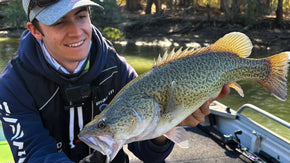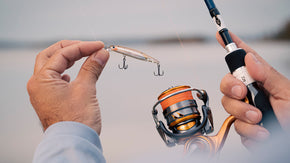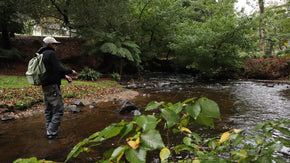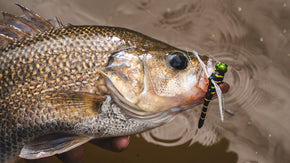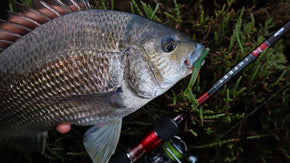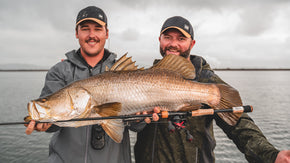Posted 30th May 2025
Luderick for Beginners: A complete guide


By Robert Thornton
Many fish species have a cult-like following amongst Aussie anglers, but for the luderick, this devotion is on another level.
Luderick, also known as blackfish, are a unique sportfish in many ways. Everything from the tackle, the techniques, the types of bait, and even the anglers themselves, differ from other angling ‘scenes’. When a luderick angler shows up to a rock ledge or break wall and begins plying their trade, everyone knows exactly what they’re chasing – even if they don’t say a word to anyone else!
There is already so much information available for anyone who wants to learn how to catch luderick. That said, most instructional pieces revolve around ‘traditional’ techniques, where centre-pin reels, long fibre glass rods and fine pencil floats are the norm. For this blog, however, we’ll look at how modern anglers with newer hardware can enjoy these awesome fish. By the end, hopefully you’ll see that this isn’t just an old-timer’s sport!
A FISH WITH HISTORY
One of the blackfishes’ unique aspects is their long history with anglers. Blackfish angling can be traced back to the 19th century, with float fishing techniques likely to have been introduced by English settlers. The name ‘luderick’ is thought to have come from an Indigenous language; however, its exact linguistic history is difficult to trace. Nevertheless, it’s likely that these fish have a history with humans that pre-dates European settlement of Australia – this much has been confirmed in New Zealand!
Luderick are found along coastal rock ledges and intertidal estuaries of the East Coast, from about Hervey Bay in Queensland down to Western Victoria, with Tasmania also known to have small populations. They are also native to parts of New Zealand, where they are known by the local name ‘parore’.
Along the coast, they are targeted from headlands and rock ledges, with most anglers still preferring to use long fibreglass rods, centre-pin reels and float rigs baited with sea cabbage.
In the winter months, blackfish school up to spawn in nearby estuaries, usually in deeper channels with plenty of tidal flow. Anglers who don’t wish to risk their safety on the ocean rocks tend to chase them during this time using the same tackle and techniques – although with slightly lighter traces and shorter rods.

HOW TO CATCH LUDERICK
The set-up
For regular customers, not much has changed in the past century, although these days it’s clear that fewer people are chasing luderick in the ‘old way’.
Older anglers invariably are sticklers for tradition, but there is more to ‘classic’ luderick tackle than simply honouring tradition. Centre-pin reels – essentially an Alvey-like design with a bearing and a 1:1 retrieve ratio – offer superior line control when fishing with float rigs in turbulent or flowing water.
Fibre glass rods, sometimes 13 or 14ft long for rock ledge fishing, allow anglers to stand back from the dangerous washes. In the estuary, 9-10ft rods are more standard. Aside from allowing the angler to stand back from the water, long rods are also beneficial for keeping small hooks in as the fish bounces around during the fight. Additionally, they are useful for quickly taking up slack when setting the hook.
Floats are another essential part of the kit. Pencil style designs work best for blackfish, as they can be weighted very delicately so that even the characteristically gentle takes from these fish will pull the float down and send the message back to the angler.
Small hooks ranging from no. 6-12 are crucial for these small-mouthed omnivores. The ideal trace can be anywhere from 14lb in rough, rocky wash zones where fish need to be washed up with the next wave, down to 4lb in clear estuaries where they can be timid and require a more finesse approach. Daiwa’s J-Thread FCmakes good trace material for blackfish.
With all that said, there’s no reason why you can’t use a spinning reel instead of a centre-pin. There’s also nothing wrong with using 7-8ft graphite rods, especially when estuary fishing from a boat. The Crossfire Surf range offer some decent graphite options, with the 862L and 1202L models good picks for estuary and rock ledge fishing respectively. What is important, though, is that everything is kept light, and hooks are kept small.
Mainlines can be monofilament or braid, however I lean toward specialised floating mono around 12lb as my preferred string. Floating mono is brightly coloured and sits on top of the water, allowing me to see it at all times. Being a floating line, it also picks up easily when striking or adjusting the drift.
Believe it or not, luderick are very responsive to fly techniques as well, and you’d be surprised how readily they will take a small ‘weed fly’ at time. Weed flies can be tied pretty easily with just a small amount of green-coloured synthetic bound around a small hook. I have even fished flies on traditional bait set-ups and done well! When I target them on fly, I like to add a small split-shot just above the fly to get it down. Above this rig, I’ll have a small indicator, which can be a small piece of foam or cotton wool. Fly tackle in the 3-6wt range is fine, and floating lines are by far the best way to fish with indicators, as they allow you to ‘mend’ line and quickly take up slack when striking.
Other than the basic set up and a bucket of green weed or cabbage, there really isn’t much else to it! If you’re not keeping any fish, you can get by with a small hip bag or sling bag carrying just some spare trace, hooks, split-shot and a pair of pliers!

Find the weed, man
As per blackfish tradition, secrecy is not so much in where the fish are, but rather where the weed is. Sea cabbage can usually be sourced from rock ledges and headlands, and anglers fishing these zones usually collect it at the spot. While fishing, bits can be scuffed up with the feet so it’s washed in with the next wave, creating a perfect natural berley trail.
In the estuaries, though, bait is rarely available on location, meaning the angler needs to have a reliable source of cabbage or weed.
Cabbage is generally happier in salty water, with rock ledges and break walls receiving a good mix of seawater and sun, the edges of pontoons, moored boat hulls and marker buoys all good places to have a look. Green weed, a far more sought-after bait in the estuaries, tends to prefer brackish and sometimes even freshwater to grow. Mangroves, driftwood, old boat hulls, cane drains, and even freshwater ponds can harbour this stuff, which resembles horsehair in texture and ranges from a translucent bright green to a dark olive colouration.
Whatever bait you to collect, you’ll need quite a bit, as estuary luderick often need to be berleyed up. A berley mixture is quite simple to make but requires some labour. I like to get a 10L bucket and fill it one third with my weed or cabbage, which is chopped finely with a knife or pair of culinary scissors. After that, I start mixing it with damp sand. Your weed to sand ratio is up to you, but I personally don’t mind having more sand than berley in there. The reason for the sand is so you can shape it into balls about the size of a tennis ball and lob them into the water. The sand helps to throw it out and then get the berley down below the surface where the luderick can find it. If your sand is too wet or dry, you won’t be able to shape the mixture into balls, so take your time during this phase.
Show time
Now you’ve got to your spot, you’ve kicked some cabbage off the ledge or tossed some berley balls into the water, it’s time to bait up! With cabbage I like to grab a small pinch and fold it a few times so I can pin it 2-3 times with my hook. The bait shouldn’t be any larger than about half the size of your thumb. Some anglers tie a half-hitch around the cabbage with their trace, however I don’t usually bother with this step.
With green weed, you’ll need to wrap it around your hook instead. When using weed, I will grab a few strands about as long as my middle finger and about half as thick. I will then lay the bait across the hook shank, wrapping the ends in opposite directions 3-4 times. After this, I pinch the ends of the bait and roll them back-and-forth, leaving the bait with a few centimetres hanging off the bottom of the hook.
Once baited up, it’s time to get your line in! Most of the time, luderick won’t venture too far from structure, so there’s no need to cast far. On the rocks, washy backwaters, gutters and chutes are prime feeding zones for blackfish. In the estuaries, snaggy channels are preferred spawning habitat, with retaining walls, break walls, bridges, collapsed mangrove banks and deep, outside river bends perfect real estate.
Knowing where to set your bait under the float is part of the challenge, although a few trial-and-error drifts is usually enough to work out where they’re sitting.
When that float finally slides under the surface – the moment of truth – how long do you wait before striking? My Dad always told me to utter the phrase “God save the Queen” before lifting the rod, and that usually works for me. Sometimes you need to wait even longer, and other days you’ll need to hit them as soon as the float disappears. Missing strikes is part of any normal luderick session, so don’t worry if you don’t hook up every time.
Another thing to prepare for is the fight. Luderick scrap well above their weight and will not hesitate to dive for cover once hooked. At one of my favourite spots in Brisbane I can expect at least one or two dustings per session, and that’s with 10-12lb trace! Once up above the 40cm mark, these fish can take some stopping, and sometimes they just can’t be stopped on standard blackfish tackle.
JOIN THE CULT
As you can see, there are many reasons to get into luderick fishing. People are attracted to this fish for different reasons, but whether it’s the exhilaration of the ocean rocks, the involved technical aspect, or the anticipation of the float going down, most anglers agree that luderick deserve their cult-like status. They’re not too shabby on the plate, either!
If you live on the East Coast and haven’t caught one, do yourself a favour this winter! You don’t have to spend a mint on tackle, the bait is free, and the skills you’ll pick up from this style of fishing will make you a better angler – trust me!










